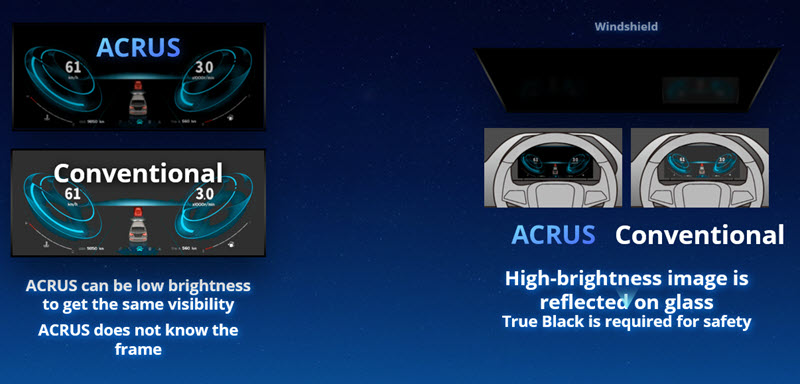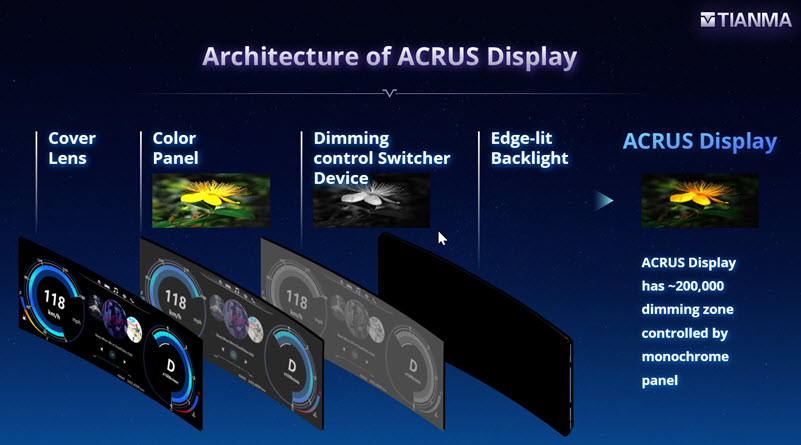Please excuse me if I return to a particular interest of mine – dual cell LCDs. I have been intrigued by the idea when Sharp showed an LCD with ‘a million to one contrast ratio’ at a CES show, years ago, although it did not admit that it was doing it that way.

(For those new to the display industry, dual cell LCDs have a monochrome LCD behind the main LCD to modulate the backlight. If each has 1,000:1 contrast, you get a multiplier effect, bringing overall contrast to 1,000,000.)
As I mentioned in an article a few days ago, dual cell has lost momentum in the TV business. I’m not surprised by this. Although the performance was impressive and the technology was fundamentally simpler than OLED and potentially higher performing than miniLED – depending on the number of zones, it was always going to be challenged in terms of power supply. Globally, TVs use a lot of power and are subject to tight international restrictions on power consumption. If you could have used just one additional glass substrate and one polariser for the backlight modulator, that would have reduced cost, weight and made it more likely that TV would be a good market, but that has not been possible.
The technology has been successful in the (very) high end broadcast/content creation monitor business, but that is a sub-segment of a niche, so volumes will be tiny and pricing very high.
Automotive Remains A Target
However, the other area where dual cell has an opportunity is in automotive applications. Car makers are comfortable qualifying LCDs, decades of work have gone into that. That’s different from the situation with OLEDs, which are only just now appearing as main displays in vehicles (as long as you can afford a big Audi or a Mercedes S-class!).
OLEDs and dual panel LCDs (as well as miniLED LCDs) are appealing because they have deep black, which help auto makers to achieve high contrast, but also means that the rectangular edges of the display can be hidden, giving a more seamless appearance to dashboards with multiple displays. Further, improving the contrast can mean that a display with lower brightness can be used, which reduces issues of reflectance in the car (e.g. from the windshield).
There was a flurry of activity with dual panel LCD in the automotive area last year. Visteon announced its microZone dual LCD technology at CES in 2020 (which Arthur wrote about it nearly a year ago (Visteon Developing New Display Technologies for Vehicles ). The firm is a major supplier of automotive instrumentation and its technology can be curved using cold forming (-5 deg + 15 deg) and it can also integrate driver monitoring.
I wrote about Flexenable, which can make dual cell LCDs using its film-based LCD technology (and that has investment from Novares – a significant automotive supplier) (Flexenable Boosts Dual LCD for Automotive (and….). The Flexenable technology significantly reduces the thickness of the layers. That helps in various ways, but in particular it helps optically. When glass is used, Flexenable pointed out, the thickness of the panels is more than the pitch, so with glass it is really hard to get pixel level contrast. Sweta reported from the SID automotive event and reported a talk by Visteon. (Vehicle Display Technologies – LCD, FALD, Dual-cell, OLED and MicroLED).
Tianma is Active
Recently, I found that Tianma, an established supplier of LCDs and OLEDs from China, has also developed dual cell LCD for automotive applications that it calls Acrus. It has a 12.3″ display that is curved to R1000 and with 2880 x 1080. Colour gamut is 110% of NTSC. Contrast is quoted at >50,000:1. It was announced at Display Week in 2020, but I admit, I missed it at the time. It also showed at SID Display Week 2020 a 12.3 ” Double Curve – the curved display is made up of a concave cluster display and a convex CID display laminated on a large s-shaped curved cover.
 Now, I couldn’t help noticing that both the Visteon and Tianma displays have 110% of NTSC colour performance. Of course, that may be a coincidence, but I suspect that the basic display is probably made by Tianma, which Visteon uses for its MicroZone (with the addition of perhaps some driving and integration ‘secret sauce’ (and driver recognition etc). After all, Visteon doesn’t make the LCDs, so it must be buying them somewhere and Visteon always mentions its patents in this area. It turns out too, that Tianma was a 2019 Visteon ‘Supplier of the Year’. (See the picture, right)
Now, I couldn’t help noticing that both the Visteon and Tianma displays have 110% of NTSC colour performance. Of course, that may be a coincidence, but I suspect that the basic display is probably made by Tianma, which Visteon uses for its MicroZone (with the addition of perhaps some driving and integration ‘secret sauce’ (and driver recognition etc). After all, Visteon doesn’t make the LCDs, so it must be buying them somewhere and Visteon always mentions its patents in this area. It turns out too, that Tianma was a 2019 Visteon ‘Supplier of the Year’. (See the picture, right)
Unfortunately, the Paris Motor Show, which took place in 2018 alongside a preview of CES (which was very convenient!) was cancelled in 2020, so there probably won’t be one until 2022. I’ll have to find another event in that world to try to see who is using this technology. (BR)



